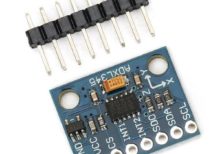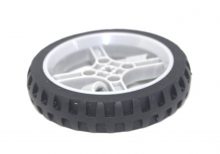|
Description |
The SG90 is a popular micro servo motor known for its small size, lightweight, and reliable performance. It is ideal for use in RC applications, robotics, and other hobbyist and DIY projects. The servo provides precise control over angular position, speed, and acceleration.
Key Features:
- Lightweight and compact design
- High precision and stable movement
- Nylon gears for smooth operation
- Compatible with most radio control systems
- Easy to interface with microcontrollers
- Includes various servo horns and mounting hardware
Technical Specifications:
- Operating Voltage: 4.8V to 6.0V
- Stall Torque: 1.8 kg/cm (4.8V), 2.2 kg/cm (6.0V)
- Speed: 0.12 sec/60° (4.8V), 0.10 sec/60° (6.0V)
- Rotation Angle: 0° to 180°
- Control System: PWM (Pulse Width Modulation)
- Gear Type: Nylon
- Connector Wire Length: 250mm
- Dimensions: 23mm x 12.2mm x 29mm
- Weight: 9g
Applications:
- RC vehicles (cars, airplanes, boats)
- Robotics
- Mechanical arms and grippers
- Pan/tilt mechanisms for cameras and sensors
- DIY electronics projects
- Animatronics
Usage:
- Connection:
- Connect the VCC (red) wire to a 5V power supply.
- Connect the GND (brown) wire to ground.
- Connect the signal (orange) wire to a PWM output on the microcontroller or servo controller.
- Control:
- Use PWM signals to control the angular position of the servo.
- Adjust the pulse width (typically between 1ms and 2ms) to move the servo to the desired position.
- Mounting:
- Use the included servo horns and mounting hardware to attach the servo to your project.
- Ensure the servo is securely mounted to handle the torque generated during operation.
Caution:
- Avoid stalling the servo for extended periods to prevent overheating.
- Ensure the servo operates within the specified voltage range to avoid damage.
- Handle the servo carefully to prevent damage to the internal gears and motor.
Datasheet:
For detailed technical specifications, refer to the SG90 Servo Datasheet.
|
The ESP8266 WiFi Shield is a versatile add-on module designed to provide WiFi connectivity to microcontrollers and development boards. It features the ESP8266 WiFi module, which offers robust and reliable wireless communication capabilities. This shield is commonly used to enable IoT (Internet of Things) applications, remote control systems, and wireless data communication in various electronic projects.
Key Features:
- WiFi Connectivity: Provides seamless WiFi communication for microcontrollers
- ESP8266 Module: Integrated with the ESP8266 chip for efficient WiFi performance
- Compatible Interfaces: Works with popular microcontrollers and development boards, including Arduino
- Easy Integration: Plug-and-play design for quick setup and use
- Power Supply: Typically powered via the host microcontroller or an external source
Technical Specifications:
- Module: ESP8266 WiFi module
- Interface: Compatible with SPI or UART (depending on the shield)
- Operating Voltage: 3.3V (ensure compatibility with your microcontroller’s voltage)
- WiFi Standard: 802.11 b/g/n
- Communication Range: Varies based on environment and antenna configuration
- Dimensions: Typically around 70mm x 55mm (varies by shield design)
- Power Consumption: Low power consumption in idle mode, higher during transmission
Applications:
- IoT (Internet of Things) projects
- Wireless data communication
- Remote control systems
- Home automation
- Sensor data transmission
- Wireless network interface for microcontrollers
Usage:
- Connection: Attach the ESP8266 WiFi Shield to the compatible microcontroller or development board.
- Power Supply: Ensure proper power supply, typically 3.3V, is provided to the shield.
- Configuration: Configure the WiFi settings and network parameters via software or firmware.
- Programming: Use development tools or libraries to program and control the shield for desired WiFi functionality.
- Testing: Verify WiFi connectivity and communication with your network or remote server.
Caution:
- Voltage Compatibility: Ensure that the shield is powered with the correct voltage (3.3V) to avoid damage.
- Heat Management: Avoid overheating during extended use; ensure adequate ventilation.
- Signal Interference: Minimize interference by positioning the shield away from metal objects and other sources of electromagnetic interference.
Datasheet:
For detailed technical specifications, refer to the ESP8266 WiFi Shield Datasheet.
|
The Servo Extender 30cm is a high-quality extension cable designed to extend the reach of your servo connections. This extender is ideal for use in RC models, robotics, and other applications where servos need to be positioned further away from the receiver or control unit. With a length of 30cm, it provides ample flexibility to route your wiring efficiently and neatly.
Key Features:
- Extended Reach: 30cm length for extending servo connections
- High-Quality Connectors: Secure and reliable standard 3-pin servo connectors
- Durable Construction: Robust materials ensure long-lasting performance
- Flexible Wiring: Easily routes through tight spaces and complex setups
- Universal Compatibility: Compatible with most standard RC servos and receivers
Technical Specifications:
- Cable Length: 30cm
- Connectors: Standard 3-pin servo connectors (male to female)
- Wire Gauge: Typically 22 AWG for reliable signal transmission
- Material: High-quality plastic and metal connectors with durable insulation
- Compatibility: Works with most RC servos and receivers
- Color: Typically black with colored signal wires for easy identification
- Weight: Lightweight for minimal impact on setup
Applications:
- RC models (airplanes, cars, boats)
- Robotics projects
- Extending servo reach in DIY electronics
- Educational and hobbyist projects
- Any application requiring extended servo connections
Usage:
- Connect the male end of the servo extender to the receiver or control unit.
- Connect the female end to the servo.
- Ensure all connections are secure and correctly oriented.
- Route the extender cable as needed to reach the servo’s location.
Caution:
- Verify the compatibility of the extender with your servos and receiver before use.
- Handle the connectors with care to avoid bending or damaging the pins.
- Ensure the extender does not interfere with other components in your setup.
- Avoid excessive bending or twisting of the cable to maintain its integrity.
|
The TFT Arduino Mega Shield is an easy-to-use, plug-and-play shield designed to interface with TFT displays, allowing for high-quality graphical displays on your Arduino Mega projects. This shield simplifies the connection between the Arduino Mega and TFT LCDs, enabling you to create visually appealing user interfaces for your projects.
Key Features:
- Easy Integration: Simplifies connection of TFT displays to Arduino Mega
- High-Quality Graphics: Supports high-resolution TFT LCDs for clear and vibrant displays
- Plug-and-Play: No soldering required, directly plugs into Arduino Mega
- Multiple Interface Options: Compatible with various TFT LCD sizes and interfaces
- User-Friendly: Ideal for creating graphical user interfaces and interactive projects
Technical Specifications:
- Display Size: 2.8″ diagonal LCD TFT display
- Resolution: 240×320, 18-bit (262,000) color
- Controller: ILI9325 or ILI9328 with built-in video RAM buffer
- Interface: 8-bit digital interface, plus 4 control lines
- Pin Usage: Digital pins 5-13 and analog 0-3 (digital pins 2, 3, analog 4, 5, and pin 12 available if not using microSD)
- Compatibility: Works with any Arduino ‘328 or Mega
- Voltage Compatibility: 5V compatible, use with 3.3V or 5V logic
- Regulator: Onboard 3.3V @ 300mA LDO regulator
- Backlight: 4 white LED backlight, on by default (transistor connection available for digital pin control)
- Touchscreen: 4-wire resistive touchscreen
Applications:
- Graphical user interfaces for Arduino projects
- Interactive displays and control panels
- DIY electronics and hobbyist projects
- Educational tools and learning platforms
Usage:
- Plug the TFT Arduino Mega Shield into the Arduino Mega board.
- Connect the TFT LCD display to the shield using the appropriate interface.
- Power the Arduino Mega board using a suitable power source.
- Upload your sketch to the Arduino Mega using the Arduino IDE.
- Use the shield’s connectors for additional features like SD card storage or touch screen input.
Caution:
- Ensure correct orientation when plugging in the shield to avoid damage.
- Use compatible TFT LCD displays to ensure proper functionality.
- Handle the shield and display with care to prevent static discharge and damage.
Datasheet: For more detailed technical information, refer to the ILI932x datasheet.
|
The GY-291 ADXL345 is a digital accelerometer module that measures acceleration in three axes (X, Y, and Z) and provides high-resolution data for gravity tilt and motion sensing applications. With its low power consumption and wide range of functionalities, it is ideal for various projects, including robotics, gaming, and industrial applications.
Key Features:
- Three-Axis Measurement: Measures acceleration in X, Y, and Z axes.
- High Resolution: 13-bit resolution with a measurement range of ±2g, ±4g, ±8g, or ±16g.
- Low Power Consumption: Operates on low power, making it suitable for battery-powered devices.
- Digital Output: I2C and SPI digital interfaces for easy integration with microcontrollers.
- Built-in Motion Detection: Features tap, double-tap, activity, inactivity, and free-fall detection.
- Tilt Sensing: Accurate gravity tilt sensing capabilities.
Technical Specifications:
- Supply Voltage: 3V to 5V
- Measurement Range: ±2g, ±4g, ±8g, ±16g
- Resolution: 13-bit
- Interface: I2C, SPI
- Data Rate: 0.1Hz to 3200Hz
- Operating Temperature Range: -40°C to +85°C
- Dimensions: 14mm x 13mm x 2mm
- Weight: 1g
Applications:
- Robotics: Motion and tilt sensing for robots and drones.
- Gaming: Enhances gaming experience by detecting motion and orientation.
- Industrial Automation: Vibration monitoring and tilt sensing in industrial machines.
- Wearable Devices: Motion detection in fitness trackers and smartwatches.
- DIY Projects: Suitable for various DIY electronics projects requiring motion sensing.
Datasheet:
For detailed technical specifications, refer to the ADXL345 Datasheet.
|
The 65mm Smart Car Tyre Narrow Wheel is designed for use in small robotics and smart car projects. These wheels provide excellent traction and durability, making them ideal for navigating various surfaces. Their narrow design allows for precise control and maneuverability, which is essential for robotics applications.
Key Features:
- Size: 65mm diameter, narrow width for precise control
- Durable Material: Made from high-quality rubber for enhanced durability and grip
- Easy Installation: Compatible with standard smart car and robot axles
- Smooth Performance: Ensures stable and smooth movement on various surfaces
- Lightweight: Lightweight construction for efficient energy use in small robotic projects
Technical Specifications:
- Diameter: 65mm
- Width: 8mm
- Material: High-quality rubber with plastic hub
- Axle Hole Diameter: 3mm
- Weight: 15g per wheel
- Color: Black
Applications:
- Smart Car Projects: Ideal for DIY smart car kits and educational robotics
- Robotics Competitions: Suitable for robotics competitions requiring precise control
- Line Following Robots: Enhances the performance of line-following robots
- Obstacle Avoidance Robots: Provides reliable movement for obstacle avoidance tasks
- Prototyping: Useful in various prototyping and small-scale robotics projects
|





